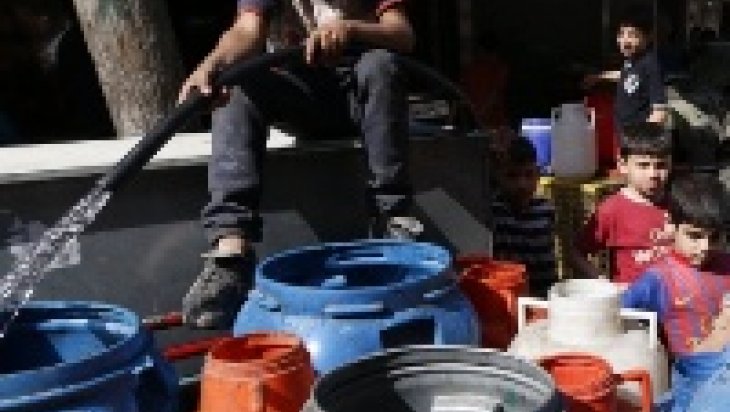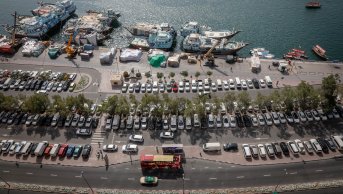Civil War in Syria and Changing Water Security Conditions

Civil War in Syria and Changing Water Security Conditions
Dr. Tuğba Evrim Maden, Researcher, ORSAM Water Programme
The Syrian civil war which has continued on since March 2011 has had a negative impact on economic, political and social structure of both the country itself and also the entire region. In addition to this, the civil war has also affected water and land resources. Today, Syria is experiencing problems caused by lack of water security that stems both from the current dry season and a negative impact of the conflicts related to the use of water resources.
Analyzing the pre-civil war period in Syria, the average precipitation rate in Syria, where partially Mediterranean and partially continental climate characteristics prevail, is around one fourth of the world average which equals to 252 mm. The estimated amount of the total water use in Syria is 15 billion m3 per year. The Euphrates and the Asi basins provide 50 percent and 20 percent of this withdrawal respectively. Since the Syria’s economy is based on agriculture, water is mainly used for agricultural purposes. Agricultural water withdrawal constitutes 87 percent of the total water withdrawal while 9 percent and 4 percent of the total withdrawal are for municipal and industrial purposes respectively. The demand for municipal water increases with each passing day due to the rapid population increase of 3.7 percent. The amount of water usage per capita is some 952 m3/year in Syria. This means that Syria was already a water-scarce country before 2011.
It is known that Syria was already going through problems related to management and equitable use of water resources before March 2011. One of the most important indicators related to this fact was observed in the Daraa province where the conflicts first broke out. Daraa is a poor agricultural territory which has been going through water shortages. Being one of the largest provinces of the Hauran plateau, Daraa has faced water shortages due to the decline in the precipitation rate and mismanagement of water resources. Even though the authorities suggest that the aforementioned problem stems from long-lasting drought, they also state that the primary cause of the problem is mismanagement of water resources and monitoring issues. Local administrations' tolerating overexploitation of groundwater resources despite the fact that it is illegal is indicated as an example of mismanagement of water resources. This caused the agricultural industry a substantial damage. Long-term water shortage led to poverty and migrations from the region. Subsequently, tribes were affected by both smuggling and a greatly damaged agricultural sector. Due to the lack of support from the regime, social tension rose gradually. It is also known that the aforesaid process in Daraa triggered the outbreak of the civil war.
After the outbreak of the Syrian civil war, water pipelines and pumping stations in particular were damaged during the conflict. In September 2012, Aleppo's drinking water pipeline was hit during a clash; and thus the people in Aleppo had to face problems regarding access to water for a prolonged period of time. In May 2014, Syrian military forces dropped bombs on the main artery of water pipelines of Aleppo. Flooding occurred in Aleppo as a result of the direct hit on the water pipeline, and the entire city's access to water was cut off. In addition to this, Syria's major dams on the Euphrates river, Tabqa and Tishrin dams, have been seized by ISIS forces. Those dams were constructed for energy generation and irrigation purposes. Both dams provide water for irrigation of a vast area of land, as well as they supply the population in Aleppo with drinking water. The seizure of both dams by ISIS directly affects agriculture, drinking water supply and electricity production for Aleppo.
The second most important river in Syria after the Euphrates is the Orontes (Asi). In 1994, Lebanon and Syria signed the “Agreement on the Distribution of Orontes River Water” on the Orontes which originates in Lebanon. In accordance with this agreement, an average of 420 million m3 of Asi River’s water supply was ceded to Lebanon and Syria, amounting to 80 million and 340 million m3, respectively.
One fourth of the agricultural products in Syria are grown in this basin, and one third of the industrial products are also provided from here. The basin hosts 53 percent of the population. In the region which once was astronghold of the Ba'ath regime, political balances changed after the implementation of a new agricultural policy in the post-2000 period. It became one of the conflitc-prone areas during the civil war. The Ba'ath regime have caused damage to 90 percent of the water structures in the basin. This situation prevented the access to drinking and irrigation water. The amount of water provided for the use of more than 50 percent of the population in the basin is 20 liters per day. The agricultural industry in the basin, in which water is used most, was greatly affected. Thus, agricultural production decreased at a rate of 70 percent. As for the dryland farming, production decreased at a rate of some 30 percent due to the facts such as: attacks in agricultural lands, and lack of fertilizer and increase in the price of seeds. In Al-Qusayr, one of the major agricultural areas of the basin, out of 6,342 agricultural wells drilled to have access to groundwater resource, 2,620 were plugged; while 20,500 ha of land dried out.
As a result, those who still live in Syria drill shallow wells or turn towards unsanitary water resources by resorting to surface waters. The lack of sanitation and poor living conditions lead to water-related diseases and child deaths. Those who have access to groundwater resources drill excessive amount of wells and thus disturb the balance of the hydrological budget. On the other hand, those who cannot have access to water resources migrate to other regions or countries. The water shortage in Syria prevents access to water which is the basic need, as well as food production and electricity. Lack of water security in addition to lack of food and energy security increase the number of people who resort to migration. The same problem has appeared with the pressure of growing population also in the neighboring countries hosting refugees within their borders with limited amount of resources, especially in Jordan and Lebanon. It is envisaged that the water security issue in Syria caused by the Syrian civil war will affect water security of all the neighboring countries by creating a kind of a domino effect.








